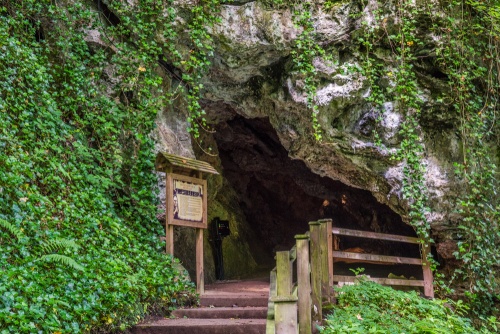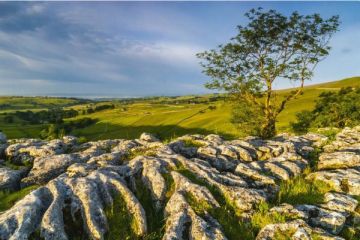
The area around Knaresborough, Yorkshire is riddled with ancient caves. The two best-known of these caves lie within an area of historic woodland on the west side of the River Nidd opposite the town. One of the caves is said to be the birthplace of the 16th-century prophetess Mother Shipton, while the other is a 'petrifying well' that turns objects to 'stone' by calcification.
Mother Shipton
Ursula 'Mother Shipton' Southeil was born sometime around 1488 and died in 1561. Her traditional birthplace was the cave that bears her name, on a slope above the River Nidd opposite Knaresborough and within a few paces of the Petrifying Well. Ursula was said to have been born during a severe thunderstorm.
Her mother was a fifteen-year-old girl named Agatha, whose last name is unknown. When Ursula's birth was discovered Agatha was called before a magistrate and questioned as to the baby's father, but she refused to reveal his name. Agatha had no family and was forced to raise Ursula by herself for two years, living in the cave where she had given birth. The Abbot of Beverley stepped in and gave Ursula to a local family to raise, while Agatha was sent to a nunnery far away. She never saw her child again.

Ursula suffered from a bent spine and crooked legs, as well as the disfiguration of a large, crooked nose. She was shunned by local people, so she spent much of her time in the woods near the cave where she was born. There she learned about the herbs and flowers that grew there and began to make healing remedies from them.
When Ursula was 24 she met a carpenter named Tobias Shipton. Whether the couple was legally married we do not know but Tobias died a few years later and from that time onward Ursula used the family name of Shipton.
She lived by providing natural remedies and potions from herbs and flowers she gathered in the woods, but she quickly gained notoriety for her predictions. She found that as her fame grew she made a much better living from her prophecies than from her remedies. She was known as Knaresborough's Prophetess, though she was regarded by some as a witch. Her fame attracted members of the nobility and the church hierarchy who consulted with her on medical issues.

She is credited with predicting events as diverse as the Spanish Armada, the Civil War, the Great Fire of London, the Great Plague, the invention of the automobile, the railroad, submarines, and iron-clad ships.
Mother Shipton was said to have terrifyingly ugly, which probably helped the notoriety of her predictions.
The first published version of her prophecies was a p[pamphlet circulated in 1641, 80 years after her death. The pamphlet was reprinted by the astrologer William Lilly in 1645, and Samuel Pepys mentions Mother Shipton in his diary of the Great Fire in 1666. Most of Mother Shipton's most famous prophecies were probably the invention of Charles Hindley, who wrote a highly creative book of her sayings in 1862.

Petrifying Well
Mother Shipton would have been intimately familiar with the Petrifying Well, or Dropping Well, a stone's throw from the cave where she was born. The well's unusual name comes from the fact that objects left in the water flow will gradually turn to stone.
It sounds like magic, but it is a simple - though rare - scientific phenomenon. The water here has very high mineral content. When it falls on an object some of the minerals are deposited on the object's surface.
Over time the minerals build up to create a hard, rock-like coating. It looks as if the object has literally turned to stone, but in fact, the stony layer merely coats the object's surface. Compare that to the process of petrification, where a whole object - such as a piece of wood - actually transforms into stone at a molecular level.
Water flows from an underground lake over a low cliff and drops into a broad pool. The calcium content of the water is so high that it quickly forms deposits on any item left in the pool or the stream of water, creating a solid coat of limestone. The range of items left by visitors to be petrified is amazing, from hats and boots to kitchen utensils and pilgrims' offerings. The most common items left in the water are small teddy bears, which take from 3-5 months to petrify. You can buy a petrified teddy bear in the museum gift shop.

Objects left in the pool or hung on strings from the cliff, gradually become coated with mineral deposits and appear to have been turned to stone.
The Petrifying Well is regarded as the oldest paying tourist attraction in Britain (ie. an attraction requiring an entrance fee to see). It was first recorded by John Leland, the royal antiquarian, in 1538. Henry VII is known to have visited the well, and it was a recognised destination for tourists from 1630 when the royal hunting ground here was sold into private hands (see below).
Visitors came not just to put objects in the mineralised waters, but because the well was reputed to have healing properties. From the 17th century, the Petrifying Well was said to aid 'any flux of the body'.

and Chris Tarrant
The Museum
The museum at the site entrance showcases objects left in the well by famous visitors, such as hats left by the actor David Suchet and the TV presenter Chris Tarrant, and a shoe left by Queen Mary in 1923.
One unusual petrified object is Agatha Christie's handbag. The famous crime novelist did not leave the handbag in the water; it was donated by the Agatha Christie Society in memory of her famous - and still unexplained - disappearance and subsequent rediscovery 11 days later at the Old Swan Hotel in nearby Harrogate.
Wishing Well
Just a few steps from the Petrifying Well is the Wishing Well, a small cleft in the rock face where water collects in a clear pool. The Wishing Well is fed by the same heavily mineralised water that runs into the Petrifying Well. It is an old tradition to make a wish at the well, and you can buy bottles of water from the well in the gift shop.

The Park
Mother Shipton's Cave and the nearby wells lie within a remnant of the ancient Royal Forest of Knaresborough. The forest was once a royal hunting ground and a favourite of monarchs like King John, who based themselves at Knaresborough Castle on the high cliff across the river.
In 1630 King Charles I sold Knaresborough Forest to Sir Charles Slingsby of Knaresborough. The Slingsby family landscaped the forest as a pleasure ground, or landscape park. Sir Henry Slingsby laid out the Long Walk, a long trail lined with trees beside the river. Then there is Beech Avenue, flanked by some of the tallest beech trees in Britain.
The trees here grow uncommonly straight and tall due to their protected habitat within the river gorge. The oldest beech was planted in 1739 when the broad promenade was created. The Beech Avenue is listed Grade II by English Heritage, one of very walks in the country to earn the designation.
The path taken by visitors to the cave and wells is the same path laid out by the Slingsby almost 400 years ago.

Getting There
Mother Shipton's Cave is just off the A59 at High Bridge, on the west bank of the River Nidd. There is also a secondary entrance near the Mother Shipton Inn at Low Bridge, reached by Bland's Hill and Briggate (the B6163). Spare a glance for the picturesque inn, a Grade II listed building dating to the 17th century.
Tickets are good for the whole day, so you can come and go as you please. There is an on-site car park, but be aware that it is not free to visitors. If you come from the south, be prepared for a long walk along Beech Avenue to reach the cave and the wells.
About Mother Shipton's Cave
Address: Prophecy Lodge, High Bridge, Knaresborough,
Yorkshire,
England, HG5 8DD
Attraction Type: Countryside - Cave
Location: Off the A59 at High Bridge.
Website: Mother Shipton's Cave
Location
map
OS: SE346565
Photo Credit: David Ross and Britain Express
NEARBY HISTORIC ATTRACTIONS
Heritage Rated from 1- 5 (low to exceptional) on historic interest
Courthouse Museum - 0.2 miles (Museum) ![]()
Knaresborough Castle - 0.2 miles (Castle) ![]()
Chapel of Our Lady of the Crag - 0.3 miles (Historic Church) ![]()
Knaresborough, St John the Baptist Church - 0.5 miles (Historic Church) ![]()
St Robert's Cave and Chapel - 0.9 miles (Historic Church) ![]()
Plumpton Rocks - 1.7 miles (Garden) ![]()
Goldsborough Hall Garden - 2.3 miles (Garden) ![]()
Tewit Well, Harrogate - 2.8 miles (Historic Building) ![]()











